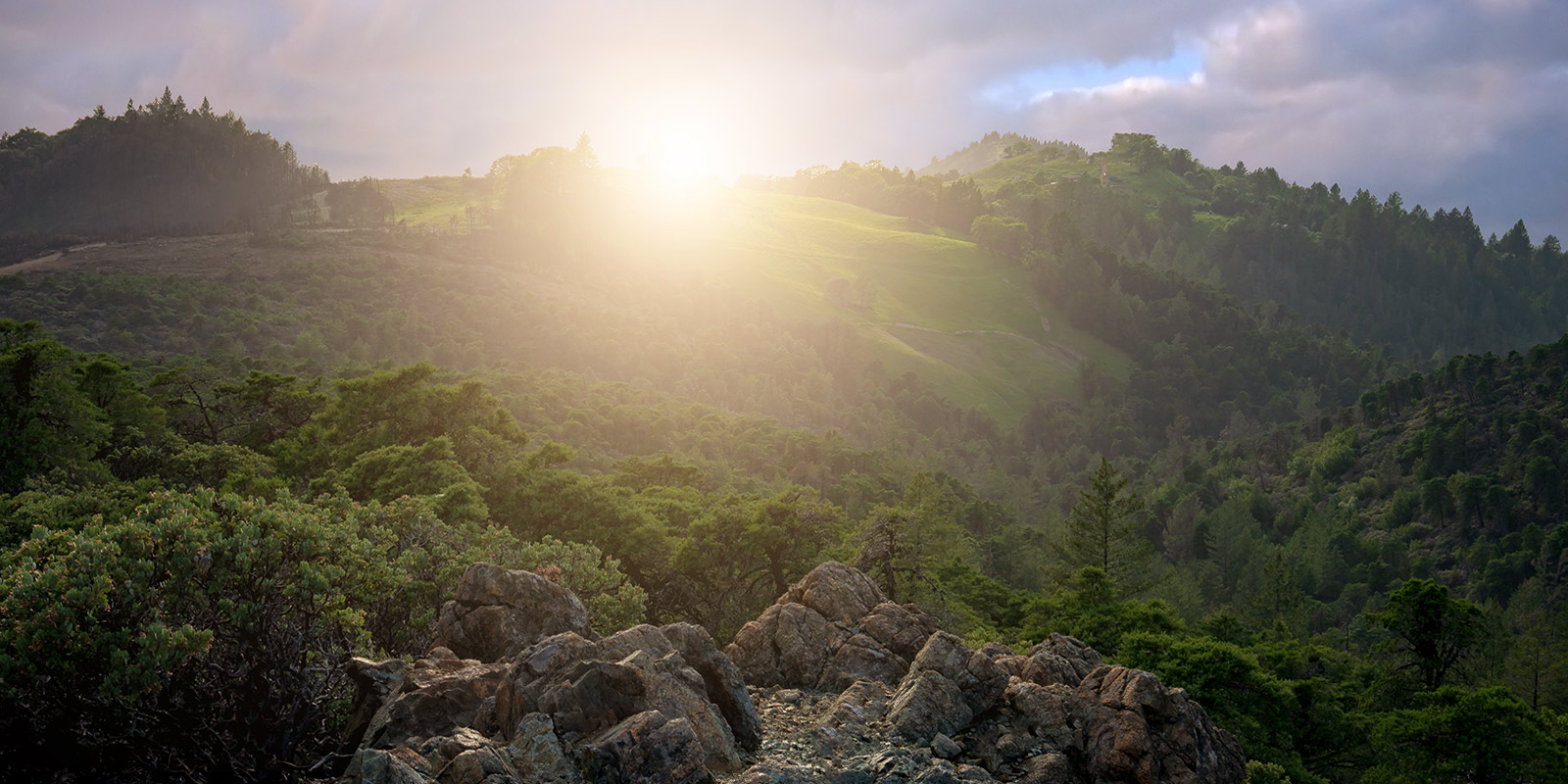Hood Mountain and the magic of fire recovery
By Melanie Parker
Visitors to Sonoma County's Hood Mountain Regional Park and Open Space Preserve may be surprised by the changes that successive wildfires have brought to this landscape above the Sonoma Valley.
 Los Alamos Road entrance to Hood Mountain Regional Park and Preserve
Los Alamos Road entrance to Hood Mountain Regional Park and Preserve
As you reach the high point on the park's Los Alamos Road entrance and begin the drive down to the trailhead, you will be met with a very different view than you may remember. Rather than gazing into a sea of tall green forests dotted with open meadows, you will be looking out across hundreds of acres of burned skeleton trees. In the distance you may see expanses of seemingly barren rock along ridgetops and ravines.
Rest assured, there is a forest here. It is just very, very short.

Tiny Sargent cypress seedling
Native regrowth
Take some time to look closely. We want to help you identify some of the most important native plants that are reclaiming the park. These little beauties are due to a wide ranging set of strategies that plants have developed in fire-prone ecosystems like the Mayacamas Mountains.
Manzanitas, like this whiteleaf manzanita, put down copious amounts of seed and those seeds are activated to sprout by fire.
 Whiteleaf manzanita
Whiteleaf manzanita
Contrast that to our wavy-leafed soap plant, which has a deeply buried large bulb and can use this stored energy to send out new leaves and flowers in the year after fire.
 Wavy leaf soap root
Wavy leaf soap root
Throughout the park you will see regenerating trees, shrubs, grasses and forbs (flower-like plants). It can be fun to try to match what you remember of the plants and what they look like now.
Note, too, that the park burned in 2017 and then again 2020. The Nuns Fire in 2017 was a moderate-intensity burn and impacted mostly the Pythian Road side of the park. The Glass Fire in 2020 was a high-intensity fire that affected mostly the Los Alamos side of the park. There are some areas along the Panorama Trail on the ridgetop that were burned and then re-burned three years later.
 Map of burned areas in Hood Mountain Regional Park and Preserve after the Nuns Fire (2017), at left, and Glass Fire (2020)
Map of burned areas in Hood Mountain Regional Park and Preserve after the Nuns Fire (2017), at left, and Glass Fire (2020)
Legacy of fire suppression
The first fire impact to Hood Mountain really came in the form of fire suppression. By removing fire from the landscape for over 100 years, the park had been getting thicker and thicker with dense forests dominated by Douglas fir. Now, with the return of fire in what was an overstocked condition, we are seeing dramatic changes. However, those changes mostly are within the natural range of conditions these hills have experienced for eons, and we can expect our oak, manzanita, madrone forests to recover.
In general, we allow forests to recover unassisted as native species recolonize on their own. In a few rare conditions, we support recovery by actively restoring the forest. You will see some active restoration along Panorama Trail, where bulldozers created a large ridgetop firebreak in 2017. Working with partners, we have installed material to slow erosion, capture sediment that would otherwise wash away in a heavy rain, and plant into the collected sediment.
 Erosion control check dam captures sediments for seedlings to take root
Erosion control check dam captures sediments for seedlings to take root
Tree removal
You will also see places where our crews have removed “hazard trees,” defined as those weak enough to likely to pose a threat to visitors hiking the trails. In many cases, those logs are left to provide downed woody debris for habitat and soil health. Where there are too many hazard trees, we chip the material and either scatter it or re-use it for other purposes in the park.
 Downed trees and other “hazard trees”
Downed trees and other “hazard trees”
Fire again?
What may happen if we see more fires in Hood? It’s possible that if we get repeat fires at short intervals, we will see much of the forest convert to shrublands dominated by ceanothus, chamise and scrub oaks. Even that, however, is part of nature’s resilience to change.
We hope you enjoy the magic of fire recovery on your next visit to Hood Mountain.
Note: Ongoing work at Hood Mountain is supported by the local Parks for All – Measure M sales tax, the Federal Emergency Management Agency, the Sonoma County Regional Parks Foundation and the Bill and Dave Legacy Fund.
Melanie Parker is deputy director of Sonoma County Regional Parks.
This post was published May 2022.



 Translate
Translate